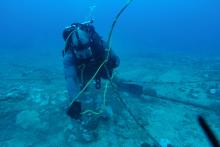If you plan to maintain your initial configuration settings over all selected PCs, choose the default installation. This worked in our labs without fail. Once complete, we could view a log file to verify the NetOp installation on selected PCs.
NetOp masters can manage their local caches in three ways: separate files for every host, a common file or no cache file. This is useful for administrators who want to keep separate log files for every session. The caching option also lets you set a maximum size for the files, to limit disk-space usage. And, like NetSupport Manager, NetOp supports Wake-on-LAN and provides record and playback features for troubleshooting and training, though the playback is rather slow and jerky.
CrossTec does not compromise on security. Rather than rely on a machine's default CSP, like pcAnywhere does, CrossTec offers AES encryption and up to 256-bit keys for authentication and to protect against third parties reading the data stream transmitted between a master and host. It also uses integrity checking to verify that data streams have not been altered and to protect against compromised keys, and offers a separate product, Security Server, to manage security.
Security Server provides enterprises with role-based remote access using SQL 7.0 or MSDE. You create roles using a wizard that can draw on user and group information from Microsoft Windows NT domains and Active Directory. If you do not use Windows domains, you can use a common user name/password, but we don't recommend this route. Instead, create your own identities with separate passwords. With roles, you can allow unfettered access to all hosts and their file systems for your domain administrators and limit others to certain activities by function, time and location. NetOp lets you limit location by IP or MAC address. Security Server also performs daily logging and log management so you know who is controlling whom, when and where on your network. If you don't use Security Server, security roles can be defined locally on each host.
NetOp supports a cascade control that let us control a host from another host we were already controlling. This activity compromises speed and can be confusing, but it may be handy for troubleshooting multiple servers or desktops from a remote location. NetOp also can operate in stealth mode, hiding the master from the host, and sports a request-for-help feature for hosts to call for service and support.









